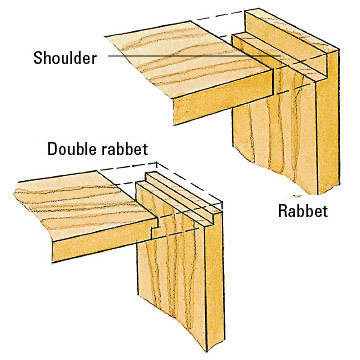|
| Examples of Joinery: - Doors and Windows: Frames, panels, and other components are joined together to create these essential building elements.
- Mortise and Tenon: A strong and versatile joint where a tenon (a projection) is inserted into a mortise (a hole).
- Lap Joint: Where two pieces of wood overlap and are joined.
- Finger Joint: A joint where interlocking fingers are cut into the ends of two pieces of wood.
Tools of the Trade: Joiners use a variety of hand and power tools, including saws, chisels, planes, drills, and jointers.
|
| Staircases | The precise joining of steps and risers is a key aspect of joinery. |
| Timber Framing | Traditional joinery techniques are used to create strong, interlocking timber structures. |
| Butt Joint | What it is:
A butt joint is a simple woodworking joint where the ends of two pieces of material are joined together, often with glue, nails, screws, or other fasteners. Definition: A butt joint is created by butting the end of one piece of material against the edge or face of another.
Common Uses: Butt joints are frequently used in framing, floor joists, and deck construction, where they are often reinforced with metal brackets or other hardware.
Strength: While simple and quick to make, butt joints are not inherently strong and often require additional reinforcement for stability.
Reinforcement: Butt joints can be strengthened with glue, nails, screws, dowels, splines, or metal plates.
Variations: There are several variations of butt joints, including edge-to-edge, face-to-face, and end-to-face joints, each with its own advantages and disadvantages.
Alternatives: For stronger joints, woodworkers often prefer other types of joints, such as mortise and tenon joints, dovetail joints, or box joints.
Other Applications: Butt joints are also used in welding, where two pieces of metal are joined by welding in a straight line.

|
| Dovetail Joint | What it is: A dovetail joint is a series of overlapping, flared connectors that join two pieces of wood. How it works: - One piece of wood has a series of "tails" (wedge-shaped pieces) cut into its end.
- The other piece of wood has a series of "pins" (grooves cut out) that fit into the tails.
- The interlocking shape of the pins and tails creates a tight, strong joint that resists being pulled apart.
Why it's used: - Strength and Durability: Dovetail joints are known for their exceptional strength and ability to withstand stress and weight over time.
- Applications: They are commonly used in furniture, cabinets, log buildings, and traditional timber framing, particularly for drawer construction.
- Through Dovetail: The most basic type, where the tails extend completely through the end of the board.
- Half-Blind Dovetail: The tails are not cut all the way through, creating a more concealed joint.
- Secret Mitered Dovetail: Used for corner joints, where the dovetails are cut on the angled edge of the boards.
- Sliding Dovetail: Used for drawer slides, where one piece slides into the other.

|
| Rabbet | What it is: A rabbet is a recess or groove cut into the edge of a piece of wood, creating a shoulder. How it works: The rabbet is designed to receive the edge of another piece of wood, creating a flush or overlapping joint. Common uses: Rabbet joints are commonly used for: - Joining sides of woodwork, such as kitchen cabinetry and drawers.
- Creating an inset in the back of a cabinet to hold the back panelling.
- Forming the joints for the ends of shelving.
The most common type of rabbet joint is a single rabbet, where only one of the mating parts is rabbeted. A more complex variation is the lock rabbet, which creates a stronger, more secure joint. - Stronger than a simple butt joint.
- Creates a flush or overlapping surface.
- Provides a large glue surface area.
- Vulnerable to cross-grain stress.
- Requires precise cutting and alignment.
- May not be suitable for all woodworking projects.
Terms: - Rabbet: The recess or groove cut into the edge of the wood.
- Rebate: The British English term for a rabbet.
- Dado: A groove cut across the face of a piece of wood, with two vertical sides.
- Groove: A groove cut along the length of a piece of wood, with two vertical sides.

|
| Dado | What it is: A dado joint involves cutting a channel (the dado) across the grain of a piece of wood, creating a slot where another piece can fit snugly. How it works: The dado is cut across the width of the wood, and the edge of a corresponding piece is then inserted into the channel, creating a strong, interlocking joint.
Why it's used: Dado joints are popular for their strength and are commonly used in applications like shelving, cabinets, and drawers, where a secure and often hidden connection is needed.
While both grooves and dados are channels cut into wood, a dado is cut across the grain, while a groove is cut with the grain.
A rabbet is a notch cut on the edge of a board, while a dado is a channel cut across the grain.
Tools: A table saw with a dado blade or a router with a dado bit are commonly used to cut dado joints.
A half dado is formed with a narrow dado cut into one part, coupled with a rabbet of another piece, which is used to hide gaps due to varying material thicknesses.
Strength: Dado joints are known for their strength and durability, making them a reliable choice for various woodworking projects.
 
|



